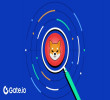7 November 2025
5 Primary Reasons for NFT Market Declination in 2022
After a brief period of increased interest, the market for NFTs has now collapsed. Since the value of several NFTs dropped significantly, their sustainability has been called into doubt. This occurred for a few different reasons, primarily due to the recent three months long sell-off in digital assets. DappRadar, an analytics tool, reports a 99 percent decrease in trade volume on OpenSea, the biggest NFT marketplace in the world, in the four months between May 2022 and August 2022. To provide some perspective, NFT is a novel, immutable asset type based on the blockchain. The best way to describe it is as anything you couldn't mass create, like a rare basketball card or an autographed jersey.
Also Read: Top 9 Cryptocurrency Exchanges France 2022
While Cryptocurrency speculators hibernate during a "Crypto winter," desire for the highly speculative digital assets plummeted in the third quarter of 2022, as reported by blockchain tracker DappRadar. NFTs, a type of resource recorded on the blockchain, may stand in for any digital content, from a picture to a movie to a gaming object. Overall sales had dropped in recent months after skyrocketing in 2021 as Crypto-rich speculators raced to cash in on increasing prices. Sales of NFTs totaled $3.4 billion in the third quarter of 2022, down from $8.4 billion in the second quarter and $12.5 billion at the first quarter's industry high.
Also Read: How To Purchase Bitcoin In China?
We’ve compiled a list of 5 primary factors that is the reason for declination in NFT market for in 2022 and below are those factors:
1. Tepid Response to Shady Practices
Many Cryptocurrency initiatives are dubious, however the NFT sector is especially fraught with fraud. Shady developers selling basic assets on marketplaces make up a significant chunk of the NFT economy. Considering how simple it is to build a site and start selling bogus art or sports memorabilia, this presented a good opportunity for con artists. The stock market is reflecting this, too. Among the major reasons why rates plummeted so dramatically is because of the lukewarm reaction to questionable behavior in the NFT sector. Nobody seems interested in these fundamental markets, and the market isn't flourishing as a result.
2. Intensive Crypto Sell-off
According to CoinMarketCap, the total value of all Cryptocurrencies on the market has decreased by 15%, from $1.02 trillion in January 2022 to $970.03 billion now. Recent trading in all of the main Cryptocurrencies has been negative, putting even the best patient of shareholders towards the challenge. When the cost of Ethereum dropped by over half, it had an immediate and profound impact on the minimum value of Non-Fungible Tokens.
3. FOMO and Shaky Investment Sentiments
Since the NFT industry's huge rise was fueled by FOMO, the industry's precipitous fall has left customers wary of putting their money into what they perceive to be a risky asset. Shareholders have stopped being interested in the NFT sector due to the fact that most firms are only peddling the most rudimentary forms of electronic currency. The majority of these reduced commodities are waiting in consolidated markets, that increases shareholder anxiety.
4. Lack of Clear Use Cases for NFTs
The primary allure of NFTs is their practical use. Anything that sells in a community may be bought and resold at a later point in time. Virtual artworks benefit greatly from this, whereas virtual currencies such as apparel and footwear really don't. Anyone can make a buck off of someone by selling them shoes, but what else could you do with the money? Since you can't use these, there's no point in buying them unless you plan on discarding them. Because of this lack of obvious practical applications, it is hard to imagine NFTs ever having any value. For this reason, digital art constitutes the overwhelming majority of NFTs. To put it simply, nothing else makes perfect sense inside the actual reality. Although NFTs' valuation may be boosted by controlled exchanges, this will not compensate for the failure of the blockchain consensus initiative.
5. NFTs Subjected to Same Problems as ICOs
As if on cue, every new blockchain initiative claims it will revolutionize the world. In reality, though, only a small percentage of Cryptocurrency initiatives end up being successful. A centralized market is a third party that profits from the selling of virtual currencies. Companies have high advertising costs and also no assurance that you will not be offered a counterfeit product. Accordingly, despite the apparent ease of using centralized exchanges, NFTs remain plagued by the same issues as ICOs. While centralized markets can assist boost digital asset value, they also have the potential to rip off shareholders. Centralized markets are merely intermediaries that take a percentage of every sale, whereas initial coin offerings (ICOs) promise to establish digital ventures. This downturn in the NFT industry is expected to continue for some time. Consumers should be aware that the Cryptocurrency exchanges are extremely unpredictable and that one cannot predict when the subsequent uptrend will occur. After rates recover, the Non-Fungible Token marketplace may be a great place to put your money
Disclaimer: The author’s thoughts and comments are solely for educational reasons and informative purposes only. They do not represent financial, investment, or other advice.






